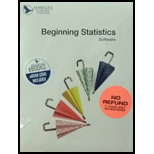
To find:
The probability that the number on the winning ticket is either even or less than 300.
Answer to Problem 22CR
Solution:
The probability of being the number on the winning ticket either even or less than 300 is 0.7917.
Explanation of Solution
Given information:
Raffle tickets for a trip to Miami are assigned three-digit numbers using the digits 0-9.
Steps:
For selection of objects from a group regard to their arrangement is the permutation.
Formula for permutation is used for counting number of selection of objects from a group regard to their arrangement.
Formula used:
Formula to calculate the probability of
For any two events
Formula to calculate the possible number of count to select
Here
Total number of digits is 10.
Required numbers are of 3 digits.
Number of random choices is 3.
Substitute 10 for
Total possible number of 3 digit number is,
Unit digit of an even number should be any one of 0, 2, 4, 6, 8.
Unit digit of an even number is fixed.
Possible choice for other two digits is 2 out of 10.
There are 5 choices for digit for getting an even number.
Substitute 10 for
Total possible number of arrangement of first two digits is,
Total number of 3 digit even numbers is,
Let
Calculate the probability of event
Hundred place of a number less than 300 should be any one of 0, 1, 2.
Hundred place digit of a number less than 300 is fixed.
Possible choice for other two digits is 2 out of 10.
Substitute 10 for
Total possible number of arrangement of last two digits is,
There are 3 choices for hundred place digit for a number less than 300.
Total number of 3 digit numbers less than 300 is,
Let
Calculate the probability of event
An even number less than 300 has 3 fixed choices (0, 1, 2) for hundredth place and 5 fixed choices (0, 2, 4, 6, 8) for unit place.
There is one choice for the tens place digit.
Substitute 10 for
Total possible number of arrangement of tens digit is,
Total number of 3 digit even numbers and less than 300 is,
Calculate the probability of event
Calculate the probability either
Conclusion:
Thus, the probability of being the number on the winning ticket either even or less than 300 is 0.7917.
Want to see more full solutions like this?
Chapter 4 Solutions
BEGINNING STATISTICS-CD (NEW ONLY)
 MATLAB: An Introduction with ApplicationsStatisticsISBN:9781119256830Author:Amos GilatPublisher:John Wiley & Sons Inc
MATLAB: An Introduction with ApplicationsStatisticsISBN:9781119256830Author:Amos GilatPublisher:John Wiley & Sons Inc Probability and Statistics for Engineering and th...StatisticsISBN:9781305251809Author:Jay L. DevorePublisher:Cengage Learning
Probability and Statistics for Engineering and th...StatisticsISBN:9781305251809Author:Jay L. DevorePublisher:Cengage Learning Statistics for The Behavioral Sciences (MindTap C...StatisticsISBN:9781305504912Author:Frederick J Gravetter, Larry B. WallnauPublisher:Cengage Learning
Statistics for The Behavioral Sciences (MindTap C...StatisticsISBN:9781305504912Author:Frederick J Gravetter, Larry B. WallnauPublisher:Cengage Learning Elementary Statistics: Picturing the World (7th E...StatisticsISBN:9780134683416Author:Ron Larson, Betsy FarberPublisher:PEARSON
Elementary Statistics: Picturing the World (7th E...StatisticsISBN:9780134683416Author:Ron Larson, Betsy FarberPublisher:PEARSON The Basic Practice of StatisticsStatisticsISBN:9781319042578Author:David S. Moore, William I. Notz, Michael A. FlignerPublisher:W. H. Freeman
The Basic Practice of StatisticsStatisticsISBN:9781319042578Author:David S. Moore, William I. Notz, Michael A. FlignerPublisher:W. H. Freeman Introduction to the Practice of StatisticsStatisticsISBN:9781319013387Author:David S. Moore, George P. McCabe, Bruce A. CraigPublisher:W. H. Freeman
Introduction to the Practice of StatisticsStatisticsISBN:9781319013387Author:David S. Moore, George P. McCabe, Bruce A. CraigPublisher:W. H. Freeman





